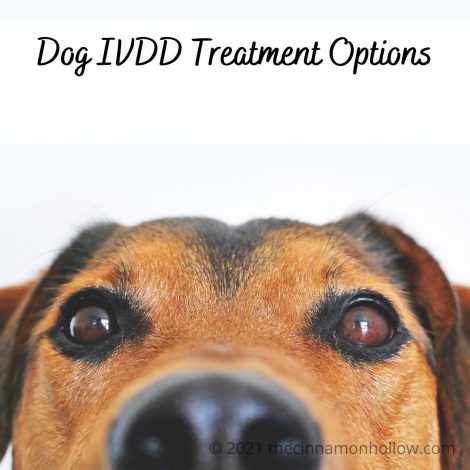IVDD in dogs is a painful condition that affects the dog’s back. The pain originates in the spine. It is caused by a slipped or bulging disk and can cause a great deal of pain for your dog.

Symptoms of IVDD
To get your dog medical care, you must recognize the symptoms and signs of this condition. They include the following.
- Dragging leg(s) while walking
- Loss of coordination
- Paralysis or lameness in the front of back legs
- Arched backed while walking or standing.
- Sensitive when the area is touched (this can cause the dog to become aggressive
- Unwillingness to move their head or neck.
- Lowered head
While there are more symptoms and signs, these are the most common that pet owners would recognize. If you notice any of these signs, you should have your dog checked by the vet.
Types of IVDD
There are two types of IVDD. Type 1 is generally caused by calcification of the discs. This condition can happen to the dog with common injuries such as stepping wrong, or even a mild injury can cause type 1 IVDD.
Type 2 IVDD is usually caused by a disc that becomes herniated. This type can occur in dogs of all ages.
Treatment for IVDD
Dog owners have several treatment options to choose from for their dogs who suffer from IVDD.
Traditional care typically starts with anti-inflammatory medications, including non-steroid anti-inflammatories and steroids. Plus, a prescription for pain. You may be instructed to apply heat or ice and rotate the ice and heat for a period to help reduce the swelling.
The dog will also be confined to a crate to prevent any more damage from happening during daily use. The vet will tell you how long your dog should remain in the crate, depending on the type of injuries, the severity, and the rate of healing. Each dog is different, so the healing time ranges widely for dogs with IVDD. Physical therapy is also a non-invasive treatment that is usually used with medications or alone; it helps strengthen and stretch the dog’s muscles which can also relieve pain.
Surgical Treatment
If your dog’s IVDD is severe and does not respond to anti-inflammatory medications or if your dog is still in pain. Dogs who are paralyzed do not generally respond well to medications. They can also develop other co-morbidities that can make the IVDD worse.
Surgery is performed to remove a part of the vertebrae that lays over the spine, as the pain comes from the spine, not the back. When part of the bone is removed, it removes some or all the pressure reducing or eliminating the dog’s pain. Surgery is not always successful. While it may relieve some pain, it is not a guarantee, especially if the IVDD is severe.
If your dog needs rehab, perform an Internet search for Dog IVDD Boulder. You will certainly be able to find a rehabilitation vet to provide IVDD care and treatment for your dog.







